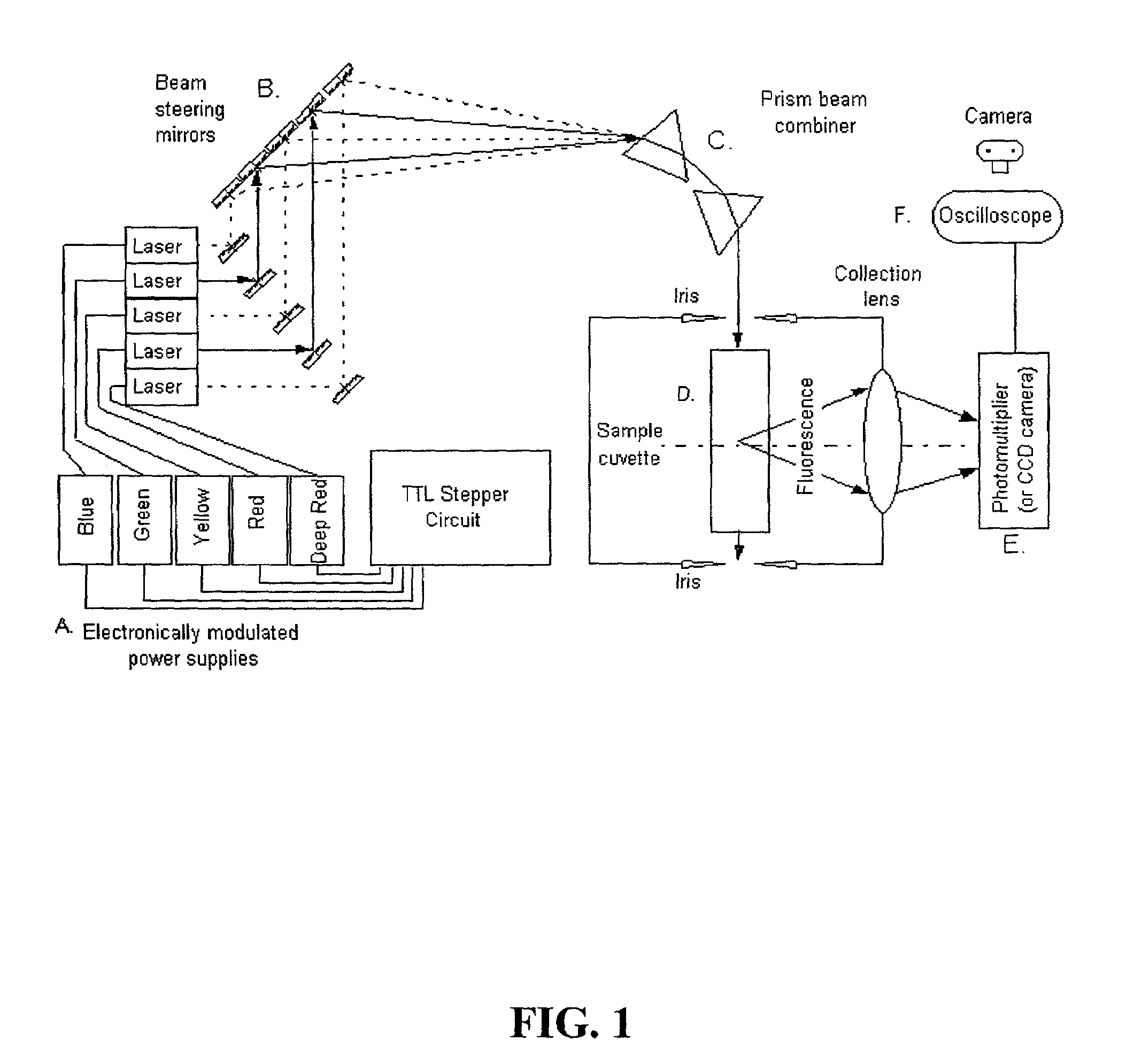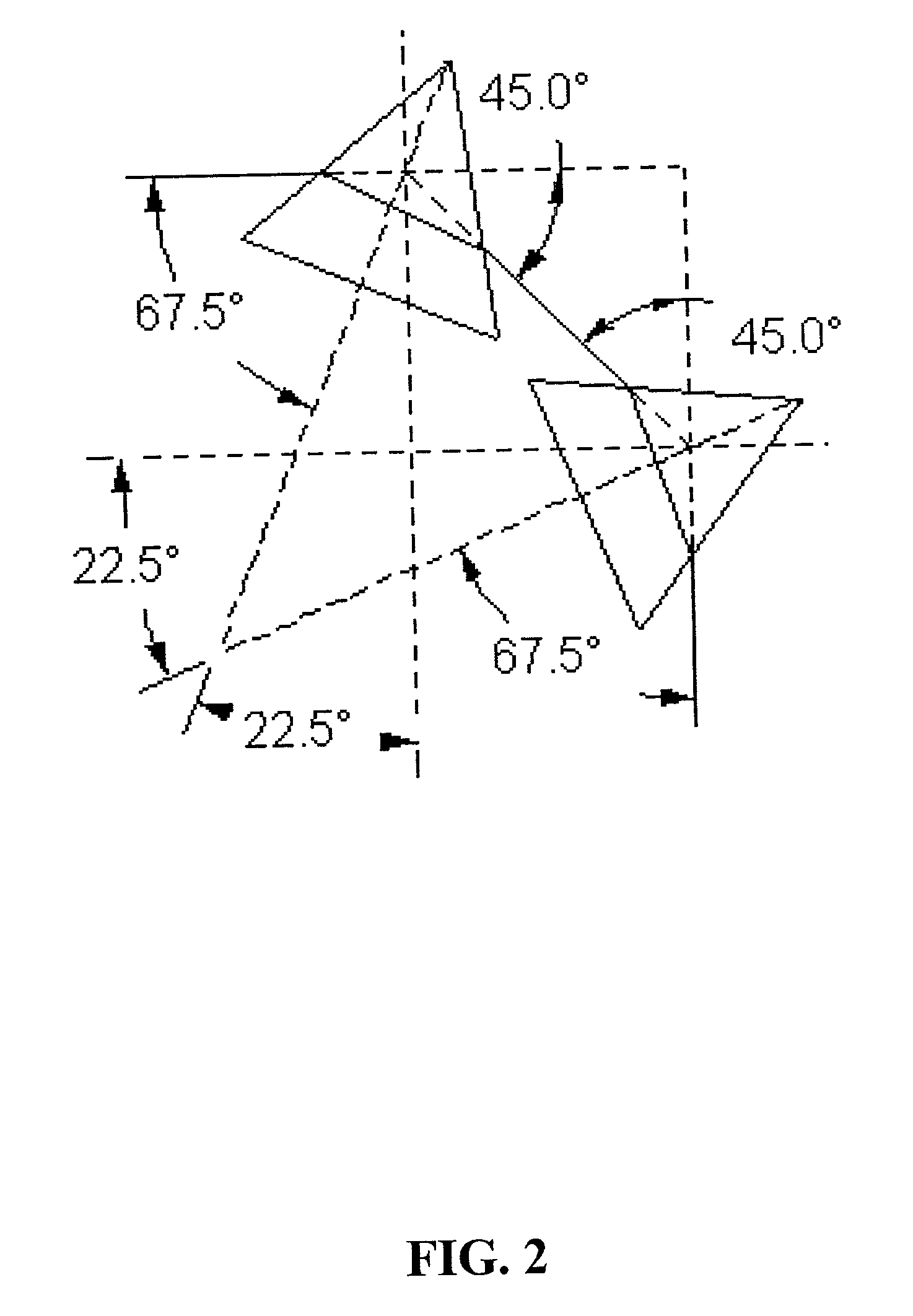Pulsed-multiline excitation for color-blind fluorescence detection
a color-blind fluorescence and multi-line excitation technology, applied in the field of high-throughput dna sequence identification, can solve the problems of inflexible resequencing of millions of individuals in routine clinical practice, large size of instruments, and insufficient cloning or amplification steps, etc., to achieve accurate diagnosis of inherited diseases and improve the prognosis of risk susceptibilities
- Summary
- Abstract
- Description
- Claims
- Application Information
AI Technical Summary
Benefits of technology
Problems solved by technology
Method used
Image
Examples
example 1
Optical system
[0134]To test the concept of the PME system, a simple breadboard device was built to test the feasibility of discriminating different fluorescent signals from a mixture of two BODIPY fluorophores (Metzker et al., 1996). The optical path for combining the pulsed 532 nm and 635 nm lines is depicted schematically in FIG. 1 as solid lines. The laser light emitted from the green 532 rim solid state, diode-pumped, frequency-doubled Nd:YAG laser (Intelite, Minden, N.Y.) and the red 635 nm SPMT diode laser module with external potentiometer (Blue Sky Research, San Jose, Cailf.) were each directed using two commercial grade aluminum steering mirrors (Edmund Industrial Optics, Barrington, N.J.) to a dual prism assembly. The prisms were coated with a single layer HEBBAR antireflection material, which reduced polarization at the prism surfaces by increasing total transmittance. The high dispersion equilateral prisms were constructed from F2, grade “A” fine annealed flint glass and...
example 2
Pulse Generation System
[0136]There are a number of methods to serially pulse multiple lasers, including mechanical chopping and TTL control. One strategy was to serially pulse the 532 nm solid-state laser and the 635 nm diode laser by TTL control using 74174-clock chip, (FIG. 3). The advantages of the clock chip TTL circuit are its simplicity and flexibility as it is designed to pulse of up to eight discrete sources. As an alternative, a TTL bucket brigade circuit was constructed because of its simplistic design in pulsing 4-lasers using 2 dual J / K flip / flop chips. The TTL Clock Chip essentially provides a means for distributing the timing pulses from a master clock on the computer to the appropriate lasers. As each clock pulse is received, the chip output sequentially shifts one step from Q0 to Q1 . . . . and finally to Q7 on the 8th clock pulse. Each laser is turned on in turn for one and only one clock pulse. The total cycle time may be easily varied by several orders of magnitud...
example 3
Results and Discussion from the 2 Color PME Study
[0137]A preliminary experiment was performed to determine the feasibility of the PME approach to discriminate each fluorophore from a mixture of fluorescence dyes. To test the concept of “colorblind” detection, this experiment was performed without the aid of fluorescence band pass filters, laser line blocking filters, gratings, prisms, or any other dispersing elements to aid in distinguishing one dye's emission from the other. Moreover, the raw output from the photomultiplier was sent directly to an oscilloscope, without signal averaging or any other type of processing enhancement. Each laser was alternately pulsed for 1.2 msec and was configured with the red laser connected to Q0 and the green laser connected to Q3, FIG. 3. Altering the green laser to Q2 gave the correct firing sequence, which verified the proper configuration of the TTL circuit (data not shown). The remaining Q inputs were idle and resulted in dark spacing between ...
PUM
| Property | Measurement | Unit |
|---|---|---|
| excitation wavelengths | aaaaa | aaaaa |
| excitation wavelengths | aaaaa | aaaaa |
| excitation wavelengths | aaaaa | aaaaa |
Abstract
Description
Claims
Application Information
 Login to View More
Login to View More - R&D
- Intellectual Property
- Life Sciences
- Materials
- Tech Scout
- Unparalleled Data Quality
- Higher Quality Content
- 60% Fewer Hallucinations
Browse by: Latest US Patents, China's latest patents, Technical Efficacy Thesaurus, Application Domain, Technology Topic, Popular Technical Reports.
© 2025 PatSnap. All rights reserved.Legal|Privacy policy|Modern Slavery Act Transparency Statement|Sitemap|About US| Contact US: help@patsnap.com



